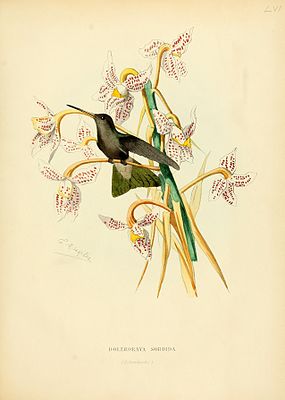Gray broad-billed hummingbird
| Gray broad-billed hummingbird | ||||||||||||
|---|---|---|---|---|---|---|---|---|---|---|---|---|

Gray broad-billed hummingbird illustrated by Paul Eugène Mesplès (1849–1924) |
||||||||||||
| Systematics | ||||||||||||
|
||||||||||||
| Scientific name | ||||||||||||
| Cynanthus sordidus | ||||||||||||
| ( Gould , 1859) |
The gray broad-billed hummingbird ( Cynanthus sordidus ) or brown-headed hummingbird is a species of bird from the hummingbird family (Trochilidae) that is endemic to Mexico . The species is considered to be monotypical . The IUCN assesses the population as Least Concern (not endangered).
features
The gray broad-billed hummingbird reaches a body length of about 9 to 10 cm, with a weight of 4.3 to 4.7 g. The male's slightly curved red beak has a black tip. The top of the head is dull green, a color that turns brownish green on the front of the head. The ear covers are blackish, the rest of the top is matt golden green. The eye stripe is white. The underside is dark gray, the slightly forked tail grayish green. The females resemble the males, but the upper bill is black and the lower bill red with a black tip. The upper side looks paler. The outer control feathers have a blackish subterminal band and white tips. Young animals are similar to the females, but the tips of the outer control feathers are yellow-brown. Most easily it can be confused with the female of the blue-throated broad-billed hummingbird ( Cynanthus latirostris Swainson , 1827).
Behavior and nutrition
The gray broad-billed hummingbird probably gets its nectar from a. of the flowers of the genera Agave , Castilleja and Opuntia . He hunts insects in flight. He gets the food in the middle to upper strata .
Reproduction
Broad-beaked gray hummingbirds' nests were discovered from March to May, August, and November to December. The breeding activities seem to be adapted to the humid times in its semi-arid habitat. The nest is a small goblet-shaped structure that is attached to branches or hangs from twigs. He uses soft plant material for construction. The outside is covered with dead leaves, small twigs and cotton, and very rarely with lichen. A clutch consists of two eggs.
Vocalizations
The singing is similar to that of the blue-throated broad-billed hummingbird, but it sounds a little softer, more fluid and chattering. It also makes dry, somewhat lively chirping sounds. The song of the blue-throated broad-billed hummingbird is described as repeating strange phrases that begin with single short bright liquid tones. These are immediately followed by deep, hoarse rattling tones, followed by a rapid series of hoarse squeaky tones. At the end there is a deep rattle. The tones sound like tslip-chschschtschschtsch-tschli-tschli-tschli-tschli-tschli-chschschtschtschschsch .
distribution and habitat
The gray broad-billed hummingbird prefers semi-open dry areas with isolated trees and scrub. Occasionally he walks along streets and in blooming gardens. It moves at altitudes of 900 to 2200 meters.
migration
The gray broad-billed hummingbird is a resident bird .
Etymology and history of research
The first description of the Gray Broad-billed Hummingbirds in 1859 by John Gould under the scientific name Cyanomyia (?) Sordida . The type specimen came from Oaxaca and was made available by Adolphe Boucard through Auguste Sallé . William Swainson introduced the new genus Cynanthus in 1827 for the blue-throated broad-billed hummingbird, which was later assigned to the gray broad-billed hummingbird. This name is a Greek result from "kyanos κυανος " for "dark blue" and "anthos ανθος " for "blossom". Sordidus is the Latin word for "shabby, dirty" from "sordere, sordes, sordis" for "to be dirty, filth".
literature
- Thomas Züchner, Guy Maxwell Kirwan in: Josep del Hoyo , Andrew Elliott, Jordi Sargatal , David Andrew Christie , Eduardo de Juana: Dusky Hummingbird (Cynanthus sordidus) In: Handbook of the Birds of the World Alive . Lynx Edicions, Barcelona.
- James A. Jobling: Helm Dictionary of Scientific Bird Names . Christopher Helm, London 2010, ISBN 978-1-4081-2501-4 .
- John Gould: Descriptions of four new species of humming-birds from Mexico . In: Annals and Magazine of Natural history including Zoology, Botany, and Geology (= 3 ). tape 4 , 1859, p. 96-98 ( biodiversitylibrary.org ).
- William Swainson: A synopsis of the birds discovered in Mexico by W. Bullock FLS and HS, and Mr. William Bullock, jun . In: The Philosophical magazine: or Annals of chemistry, mathematics, astronomy, natural history and general science (= 2 ). tape 1 , no. 85 , 1827, pp. 433-442 ( online ).
Web links
- Cynanthus sordidus inthe IUCN Red List of Threatened Species 2019.1. Listed by: BirdLife International, 2016. Retrieved July 14, 2019.
- BirdLife International: Species Factsheet - Dusky Hummingbird ( Cynanthus sordidus ) . Retrieved July 14, 2019.
- Videos, photos and sound recordings for Dusky Hummingbird (Cynanthus sordidus) in the Internet Bird Collection
- Broad-billed gray hummingbird ( Cynanthus sordidus ) at Avibase; accessed on July 14, 2019.
- Cynanthus sordidus in the Integrated Taxonomic Information System (ITIS). Retrieved July 14, 2019.
- xeno-canto: Sound recordings - Gray broad-billed hummingbird ( Cynanthus sordidus )
- Dusky Hummingbird (Cynanthus sordidus) in the Encyclopedia of Life . Accessed July 14, 2019.
Individual evidence
Remarks
- ↑ The first description probably appeared in The Philosophical magazine . However, it cannot be ruled out that it first appeared in The Zoological journal from the same year.
